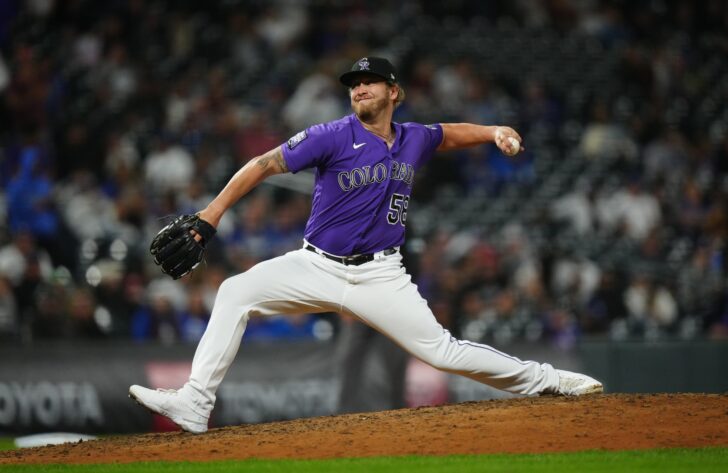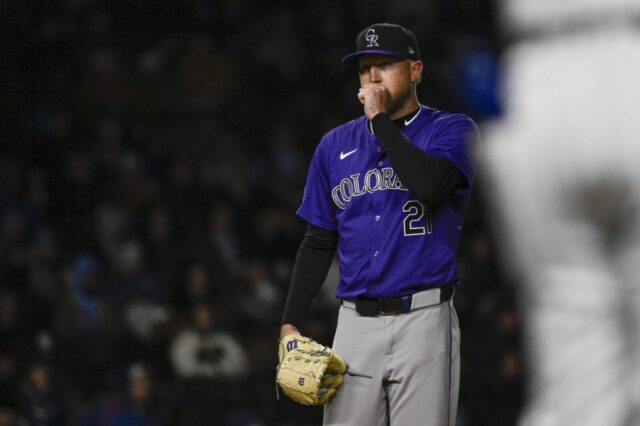The Colorado Rockies’ bullpen, entering the 2021 season, wasn’t expected to do a whole heck of a lot. Sure enough, that’s the best way to describe the unit in hindsight.
Only three National League bullpens contributed less in terms of value than that of the Rockies, who collectively finished a couple of wins above replacement level as a group. That was a step up from “historically bad,” which is what was bandied about regarding the 2020 unit. But that’s because no bullpen in the last 50 years allowed a higher percentage of inherited baserunners to score than that group. They struggled again in that category in 2021, but only to the tune of fourth-worst in the NL.
The loss of Scott Oberg to another round of blood clot complications didn’t do the Rockies’ relief corps any favors. Daniel Bard resumed his closer duties to mostly negative results and even lost his job to Carlos Estévez down the stretch. Estévez was inconsistent himself, injuries mounted, and the Rockies were left to figure out the right mix of inexperienced arms and wily vets just to make it through the season. But, they did (sort of), and here’s the gist of how it happened.
Most valuable: Robert Stephenson (0.8 rWAR, 0.5 fWAR)
What happens when a pitcher induces a career-best percentage of grounders, limits home runs, and throws harder than ever? Ask Stephenson, who quietly posted a solid 3.13 ERA with 52 strikeouts in 46 innings. The right-handed reliever, acquired from the Cincinnati Reds last offseason in a trade involving former top prospect Jeff Hoffman, increased his average fastball velocity to nearly 97 mph en route to becoming one of Colorado’s most reliable bullpen options. Unfortunately, Stephenson missed almost two months during the middle chunk of the season with an injury, but his performance while healthy gives the Rockies’ bullpen some hope going forward.
Least valuable: Yency Almonte (-1.1 rWAR, -0.5 fWAR)
Almonte was terrific in 2020, posting a 2.93 ERA in 27 2/3 innings during the shortened season. But he was unable to build on that momentum in 2021 due to a sharp increase in walks, homers, and hard contact. Almonte also lost a tick off of his fastball, and his slider–a legitimate weapon in 2020–failed him repeatedly.
The end result was a 7.55 ERA and, ultimately, the Rockies’ decision to outright him off of the 40-man roster and back to the minors. The outlook for Almonte isn’t all bad, though; after returning on Aug. 6 from a month-long Triple-A stint, the 27-year-old right-hander posted a respectable 3.48 ERA with 23 strikeouts in 20 2/3 innings spanning 17 appearances.
Biggest surprise: Lucas Gilbreath (0.9 rWAR, 0.2 fWAR)
The Rockies entered the season without a single proven lefty in their bullpen, but they very well might have one now. Gilbreath overcame a rough start to 2021 to post a 3.38 ERA with 44 strikeouts in 42 2/3 innings and did so while seeing a big increase in role importance. He was especially effective in the second half; from July 16 through the end of the season, Gilbreath put up an ERA of 0.96 with 30 strikeouts in 28 innings over 29 games. He’s still a bit of a work in progress, as his 4.9 BB/9 would suggest. But if the 25-year-old Colorado native can improve command of his secondary offerings to go along with a terrific fastball, Gilbreath has a chance to have a long career as a high-impact reliever.
Biggest disappointment: Ben Bowden (-0.6 rWAR, 0.0 fWAR)
It might not be entirely fair to a rookie hurler such as Bowden to place him in this category, but hear me out. He spent the last couple of minor league seasons pitching well enough to bust down the door to the majors, but the opportunity didn’t come until arguably a year and half past when it should have. So, what did Bowden do? Struggled–and, at times, mightly. The biggest problem for the 27-year-old southpaw was walks; he issued more than five of them per nine innings, making his 10-plus K/9 a little less meaningful.
Bowden, particularly right after the All-Star break, showed flashes of being the reliever many thought he’d be very shortly after being drafted in the second round in 2016 out of Vanderbilt. But overall, his fastball velocity is way down from where it was a couple of seasons ago, and his offspeed pitches aren’t good enough yet to make up for it. The Rockies would be smart to give him the opportunity to hone his craft at the big league level, though, because the upside is still there.
What happens next?
Overcoming a bad start to the year was a theme for many Rockies relievers, including Jhoulys Chacín, who allowed runs in only two of 17 total appearances during July and August. Chacín hardly missed any bats, but was effective overall. The veteran right-hander is now a free agent, a distinction he doesn’t share with any other Rockies reliever.
Should the team want to upgrade its up-and-down bullpen, getting a proven closer would be a good start. There are a ton of them available in free agency, but given the Rockies’ recent track record in that area, owner Dick Monfort might be reluctant to spend much money for one. Corey Knebel, Raisel Iglesias, and Kendall Graveman represent some of the better names available.



